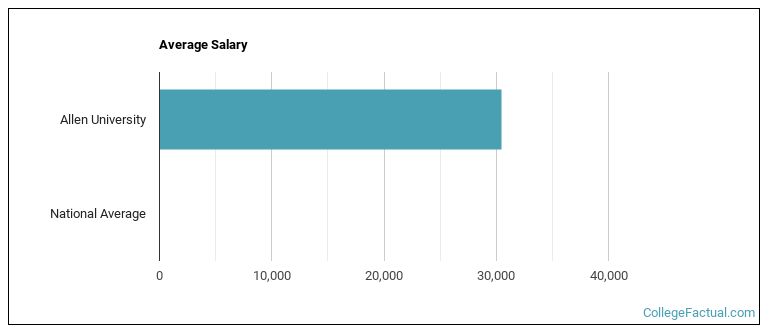 by our College Data Analytics Team
by our College Data Analytics TeamExplore the best ranked schools for the programs you are most interested in.
Allen U was not ranked in College Factual's 2025 Best Overall Colleges report. This could be for a number of reasons, including lack of data.
The acceptance rate at Allen University is a competitive 43%, so make sure you take your application seriously when putting it together. Even leaving out a minor detail could be a reason to move you to the rejection pile.
The student to faculty ratio at Allen University is about average at 15 to 1. This ratio is often used to gauge how many students might be in an average class and how much time professors will have to spend with their students on an individual level. The national average for this metric is 15 to 1.
When estimating how much access students will have to their teachers, some people like to look at what percentage of faculty members are full time. This is because part-time teachers may not have as much time to spend on campus as their full-time counterparts.
The full-time faculty percentage at Allen University is 62%. This is higher than the national average of 47%.
The freshmen retention rate is a sign of how many full-time students like a college or university well enough to come back for their sophomore year. At Allen University this rate is 58%, which is a bit lower than the national average of 68%.
When we say that a student has graduated on time, we mean that they have finished their bachelor's degree within four years. The on-time graduation rate at Allen U is 8%. That's lower than the national rate of 33.3%
Find out more about the retention and graduation rates at Allen University.
During the 2017-2018 academic year, there were 656 undergraduates at Allen U with 577 being full-time and 79 being part-time.
| $0-30 K | $30K-48K | $48-75 | $75-110K | $110K + |
|---|---|---|---|---|
| $13,399 | $12,912 | $13,921 | $18,069 | $22,959 |
The net price is calculated by adding tuition, room, board and other costs and subtracting financial aid.Note that the net price is typically less than the published for a school. For more information on the sticker price of Allen U, see our tuition and fees and room and board pages.
While almost two-thirds of students nationwide take out loans to pay for college, the percentage may be quite different for the school you plan on attending. At Allen U, approximately 85% of students took out student loans averaging $6,009 a year. That adds up to $24,036 over four years for those students.

Get more details about the location of Allen University.

Contact details for Allen U are given below.
| Contact Details | |
|---|---|
| Address: | 1530 Harden Street, Columbia, SC 29204 |
| Phone: | 803-376-5700 |
| Website: | https://www.allenuniversity.edu/ |
| Most Popular Majors | Bachelor’s Degrees | Average Salary of Graduates |
|---|---|---|
| Theological & Ministerial Studies | 14 | NA |
| Health & Physical Education | 11 | NA |
| Mathematics | 9 | NA |
| General Biology | 8 | NA |
| General Social Sciences | 8 | $23,095 |
| Criminal Justice & Corrections | 5 | NA |
| General English Literature | 4 | NA |
| Music | 3 | NA |
| Business Administration & Management | 1 | $23,572 |
| Religious Studies | 1 | NA |
Online courses area a great option for busy, working students as well as for those who have scheduling conflicts and want to study on their own time. As time goes by, expect to see more and more online learning options become available.
In 2022-2023, 144 students took at least one online class at Allen University. This is an increase from the 78 students who took online classes the previous year.
| Year | Took at Least One Online Class | Took All Classes Online |
|---|---|---|
| 2022-2023 | 144 | 61 |
| 2021-2022 | 78 | 20 |
| 2020-2021 | 705 | 12 |
| 2018-2019 | 121 | 0 |
If you’re considering Allen University, here are some more schools you may be interested in knowing more about.
Curious on how these schools stack up against Allen U? Pit them head to head with College Combat, our free interactive tool that lets you compare college on the features that matter most to you!
Footnotes
*The racial-ethnic minorities count is calculated by taking the total number of students and subtracting white students, international students, and students whose race/ethnicity was unknown. This number is then divided by the total number of students at the school to obtain the racial-ethnic minorities percentage.
References
More about our data sources and methodologies.